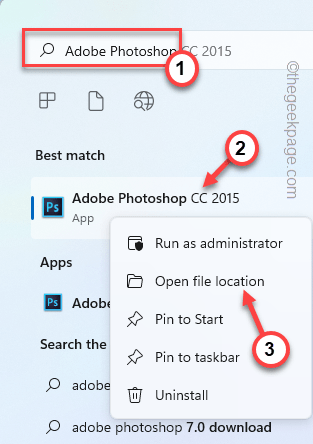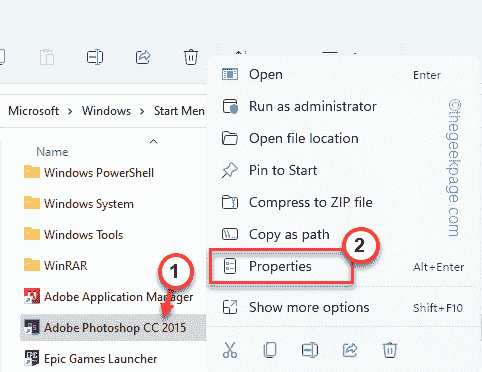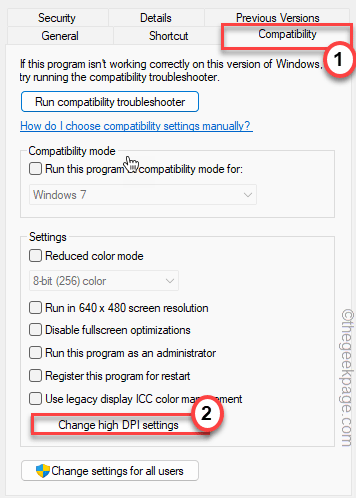The default display scaling feature on Windows 10 or further is a core component of Windows OS. But sometimes this feature for some specific apps can cause compatibility issues, unreadable texts, blurry signs, and ultimately app crashes. It is quite a headache if you are working on a 2160p resolution or higher. There are many ways to disable the default display scaling feature on High DPI settings. We have chosen the best ones and detailed the step-by-step instruction for each process.
How to disable the display scaling feature on High DPI settings
There is a way where all you have to do is to disable the high DPI scaling feature for individual apps and there is a way to disable it throughout Windows.
Disabling High DPI settings for individual apps
Way – 1 Disable the high DPI individually
You have to disable the high DPI scaling feature for only the conflicting apps.
NOTE – For example, we have taken Adobe Photoshop CC 2015. We are going to disable high DPI settings for this app only.
1. Press the Windows key and type “Adobe Photoshop“(In your case, just type the name of the app).
2. Then, right-click on the app and tap on “Open File Location“.
This should lead you to the location of the executable file.
[If it does lead you to the shortcut file, right-click on the shortcut file again and tap on ‘Open File Location’.]
3. Once you have found the main executable file, right-tap it and tap on “Properties“.
4. Then, go to the “Compatibility” section.
5. Here, tap on the “Change high DPI settings“.
6. Next, go to the ‘High DPI scaling override’ settings.
7. Then, just check the “Override high DPI scaling behavior. Scaling performed by:” box.
8. Set the drop-down to “Application“.
[
There are three options for DPI scaling performers.
Application – Application will take precedence scaling the display itself.
System – This is the default Windows behavior.
System (Enhanced) – Using this feature allows Windows to enhance the menu and texts.
]
9. Finally, tap on “OK“.
10. Coming back to the original Properties window, tap on “Apply” and “OK“.
Once you are done, open the app again and check the scaling behavior again.
Way 2 – Use Registry Editor
Besides the scaling feature, there isn’t any definitive way to stop the high DPI scaling feature. You can tweak your registry and create a separate manifest file for the problematic app.
1. Write “regedit” in the search bar.
2. Then, tap on “Registry Editor” to access it.
NOTE –
You should always take a registry backup before you make any changes in your registry. Just follow these steps –
a. After opening the Registry Editor, tap on “File” and “Export“.
b. Then, name this backup and save it somewhere safe.
You can use this backup to restore the registry if anything goes wrong.
3. When the Registry Editor opens up, navigate this way –
HKEY_LOCAL_MACHINE\SOFTWARE\Microsoft\Windows\CurrentVersion
4. Now, on the right-hand pane, right-click on the space and tap on “New>” and “DWORD (32-bit) Value” to create a new value.
5. Then, name this new value as “PreferExternalManifest“.
6. Finally, double-tap the value to set it.
7. Now, set the value to “1“.
8. Then, click on “OK” to save the changes.
Close the Registry Editor.
9. Open Notepad.
10. In the empty Notepad page, copy-paste the following lines.
<?xml version="1.0" encoding="UTF-8" standalone="yes"?> <assembly xmlns="urn:schemas-microsoft-com:asm.v1" manifestVersion="1.0" xmlns:asmv3="urn:schemas-microsoft-com:asm.v3"> <dependency> <dependentAssembly> <assemblyIdentity type="win32" name="Microsoft.Windows.Common-Controls" version="6.0.0.0" processorArchitecture="*" publicKeyToken="6595b64144ccf1df" language="*"> </assemblyIdentity> </dependentAssembly> </dependency> <dependency> <dependentAssembly> <assemblyIdentity type="win32" name="Microsoft.VC90.CRT" version="9.0.21022.8" processorArchitecture="amd64" publicKeyToken="1fc8b3b9a1e18e3b"> </assemblyIdentity> </dependentAssembly> </dependency> <trustInfo xmlns="urn:schemas-microsoft-com:asm.v3"> <security> <requestedPrivileges> <requestedExecutionLevel level="asInvoker" uiAccess="false"/> </requestedPrivileges> </security> </trustInfo> <asmv3:application> <asmv3:windowsSettings xmlns="http://schemas.microsoft.com/SMI/2005/WindowsSettings"> <ms_windowsSettings:dpiAware xmlns:ms_windowsSettings= "http://schemas.microsoft.com/SMI/2005/WindowsSettings" >false</ms_windowsSettings:dpiAware> </asmv3:windowsSettings> </asmv3:application> </assembly>
11. Now, tap on “File” and “Save As…“.
12. In the ‘File name:’ box, write the executable file name and append the “.mainfest” at the end of the name of the notepad file.
[
Example – Suppose, you are facing this issue with photoshop.exe. So, the name of this notepad file should be – “photoshop.exe.manifest“.
]
13. Set the ‘File type:’ to “All files“.
14. Then, navigate to the desktop.
15. Finally, tap on “Save” to save the file.
After this, close the Notepad screen.
16. Finally, move this new manifest file to the root directory of the app you are facing this trouble with.
[
Example – As in our case, we have to move the “photoshop.exe.manifest” file to the root folder of the photoshop.exe, that is –
C:\Program Files\Adobe
]
After that, close the File Explorer.
Now, try opening the app and checking whether the texts are appearing to be burry or not.
Way 3 – Using DPI Awareness Enabler
If you don’t like generating a manifest file for each app that is showing blurry texts, you can use the DPI Awareness Enabler.
1. Download DPI Awareness Enabler.
2. When it is downloaded, extract the “DPI Awareness Enabler” file.
3. Once it is extracted, right-click on the “DpiAwarenessEnabler” app and tap “Run as administrator” to run the application.
4. Let the app detect the list of all apps.
5. Then, select the app from the upper box. Then, drag the app from the upper box down to the lower box.
This will turn off the high DPI devices feature for all the apps present in the lower box.
That’s it! So, this way, you can easily disable the high DPI feature simply by dragging-dropping the exe file in the DpiAwarenessEnabler app.
Process 2 – Disable the high DPI throughout the system
There is another way where you can disable the high DPI settings throughout the system.
Way 1 – Use Settings
1. At first, press the Windows key+I keys together.
2. Then, tap on the “System” settings.
3. After that, on the right-hand pane, click on the “Display” settings.
Display settings will be visible.
4. On the right-hand side, tap on the “Scale” option.*
5. Now, you can toggle the count from the drop-down.
Launch the app on your system and check.
Your screen will turn off once and appear once again. Now, minimize Settings and then, launch the problematic app.
If this solves the issue, you don’t have to follow any further steps.
*NOTE –
If you see that the drop-down list is greyed out and you can’t modify the scaling, follow these steps.
1. Tap the arrow button in the “Scale” settings.
2. Here, you will find the ‘Custom Scaling’ box.
You can write anything between 100-500. [Example – Suppose you want 125% scaling, just type “125” in the box. ]
3. Once you are done, tap on the tick mark to apply the custom scaling.
You have to sign out from your account to enact the custom scaling.
4. Just, tap on “Sign out now” to sign out from the machine.
You will be signed out of your current account automatically. You can just sign back into the system and test the app.



